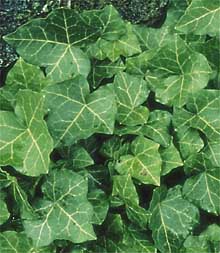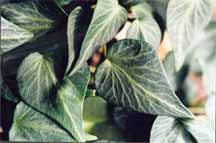

Ivy is my favorite plant and my article aims to give basic information about Ivy.
History of Ivy and Uses:
Ivy is only native to Europe, North Africa, and Asia. Archeologists have dated ivy pollen found at ruins to 5600 B.C. One of its earlier uses by humans was the symbol of an ivy plant if front of a store meaning that they sold wine. Another use was in a concoction with vinegar and rose oil to cure headaches. Ivy was also used to cure skin blemishes and bladder stones.
Plant Classification:
Taxonomists grouped ivies by thier juvenile leaves, which are quite distinct from other plants. Another feature of ivy that is used in the classification is the tiny hairs on the leaves and stems.
Ivy belongs to the plant genus "Hedera". There are many different types of Ivy, over 300 in fact.

I have chosen to focus on the species of English Ivy because it is a
very traditional Ivy that most people would recognize. English Ivy is in
the Araliaceae Family. It is an evergreen woody vine plant. It has dark
green leaves that are plamately lobed, either in three or five lobed shapes.
The leaves are typically 2 to 4 inches long. There are heart shaped or
round leaves, and many have differential lobe numbers as well.Plant leaves
are generally
heart-shaped, and mat be waxy or satiny. Leaves mat be variegated or
marbled with white,
yellow or silver.
Pierot System of Classification
Since there are many forms or varieties of Ivy, a classification system
has been developed to "code" ivy. The system was developed by Suzanne Pierot
in her work, The Ivy Book, The Growing and Care of Ivy and Ivy Topiary
(Macmillan, 1974), (Garden by the Stream,1995).
The eight-category system classifies leaf shapes found among ivy.
Note: cultivars may fall into more than one category. The American
Ivy Society has
adopted this system as a consistent and convenient way to identify
ivy.
'TEARDROP' SELECTED AS "IVY OF THE YEAR" 2002

GROWING TIPS
Light: Ivies like four or more hours of direct sunlight, but can grow
well in indirect light. An indirect light source commonly used is light
reflected from walls.
Water: Keep soil moist, but do not allow the soil to remain
constantly wet.
Temperature: Maintain
temperatures between 65 and 80
degrees.
Resouces
http://www.unitedstatesfloral.com/ivy_plant.html
http://www.gardenguides.com/flowers/perinnials/ivy.htm
http://www.gardennetwork.tripod.com/plants_info/english_ivy.htm
http://www.suite101.com
http://www.ivy.org
Links